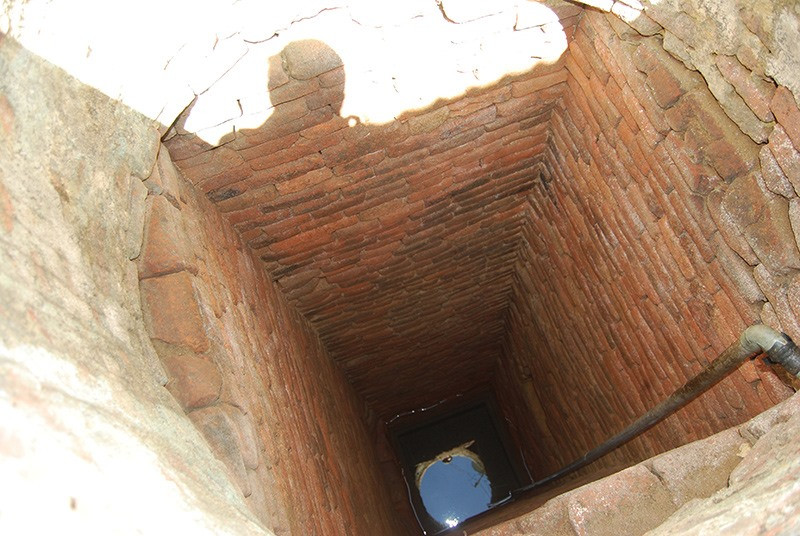
Cham well is next to the summer house of Mr. Tran Hung Thanh (Tam Xuan 1 commune, Nui Thanh district, Quang Nam province). Photo: HOANG MINH
Ancient well next to the ancient Champa tower
If Cham towers - floating structures - are lingas (symbolizing the penis), then Cham wells - submerged structures - can also be considered yoni (symbolizing the vagina), a pair of symbolic worship objects. for the survival principle of Brahmanism, which is the belief of the Cham people.
From the belief in the durability of the bricks they made, the ancient Cham people used the same bricks to build towers to build wells.
It can be said that through grinding and grinding experiments: scooping water to grind bricks at ancient Cham wells, we can still see the amount of brick powder created during the grinding process (to become a kind of paste that binds two bricks together when grinding). building bricks), as well as being able to carve patterns on the bricks without breaking them, which are special features only found in Cham bricks used to build ancient towers.
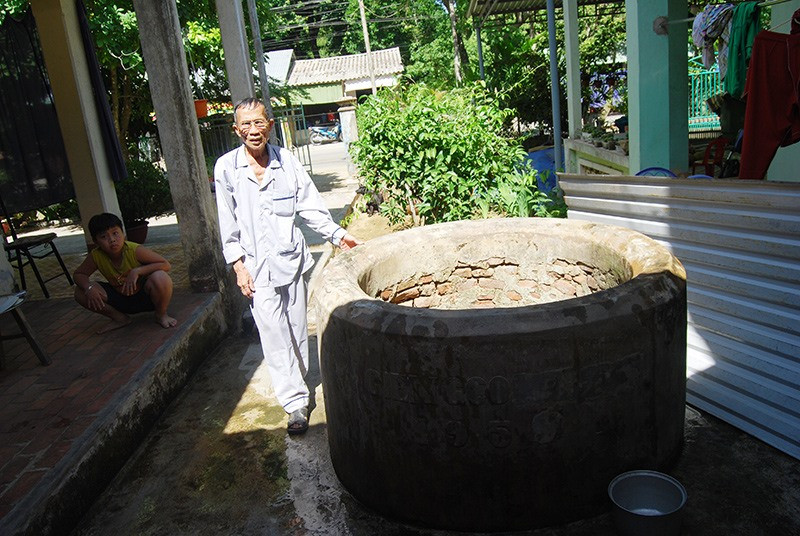
Mr. Nguyen Van Mich at the Cham well in his yard in Khuong My village (Tam Xuan 1 commune, Nui Thanh district, Quang Nam province). Photo: HOANG MINH
Along with the miraculous existence of bricks used to build wells immersed in water for more than a thousand years (estimated according to the age of the Cham towers, pagodas, and ports where ancient Cham wells are located), what is worth mentioning is the talented of the ancients in finding these eternal springs of water.
The remaining ancient Cham wells in Quang Nam are all located in clusters, with 2 or more wells. First of all, there is a cluster of 2 round wells in Suoi village (An Thien village, Tam An commune, Phu Ninh district, Quang Nam province), about 1km south of Cham Chien Dan tower.
Located right at the beginning of the hamlet, the well in Mr. Ho Van Xuan's garden is about 4,5m deep, 1m in diameter, the bottom of the well is covered with a pan-shaped sandstone block, in the middle of the basin is carved as deep as a large bucket.
According to Mr. Xuan, this well never runs dry and is the source of drinking water for both An Phu Nam and An Phu Bac villages during droughts.
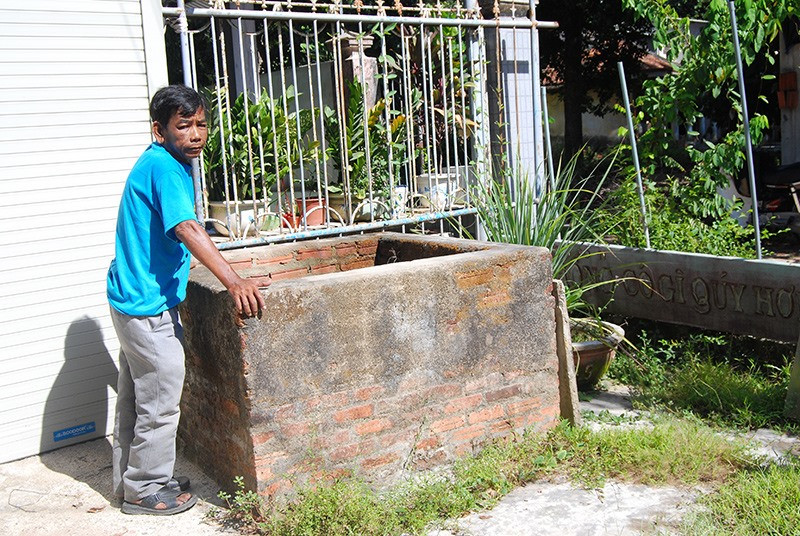
Ancient Cham well in Mr. Vo Lang's garden (Tam Xuan 1 commune, Nui Thanh district, Quang Nam province). Photo: HOANG MINH
The well in Mr. Vo Doi's garden is located at the end of Suoi hamlet, next to Ong Thu stream. This well is about 5m deep, the bottom is not covered with sandstone, and is still the source of drinking water for 4 families near the well.
Mr. Doi said that during times of drought, this well still has about 3 meters of water full. During the dry season, it takes up to 3 motors and a suction pump to dry out after a few hours to dredge and clean the well.
In years when the drought lasts so long that residents try to dig deep into the stream bed and still have no water, this well is a reliable source of drinking water for nearby Hoa Tay villagers.
The cluster of 4 ancient Champa wells near Khuong My Cham tower (Tam Xuan 1 commune, Nui Thanh district, Quang Nam province) are all square wells.
In addition to an ancient well located about 1m from the base of the tower, the remaining 40 wells are in the gardens of Mr. Nguyen Van Mich, Tran Hung Thanh, Vo Lang, all located in the west of the tower, the farthest well is only about 3m from the tower. Located on hilly land with equal levels, these 400 wells are all 4 - 5m deep and about 7 - 1m wide.
Mr. Nguyen Van Mich (81 years old) said: "The great drought lasted for nearly 2 years from 1952 - 1953, people in the surrounding villages relied entirely on the water source of these 4 ancient wells. People come here to get water day and night, but not a single well runs dry, the water from the well is clear and sweet. The ancients were so good at looking at the land and finding water sources!”.
Ancient well next to the old port, old pagoda
The remaining cluster of Cham wells in Trung Phuong village (Duy Hai commune, Duy Xuyen) is also located next to once famous Cham relics: Trung Phuong port, Trung Phuong pagoda, about 3km southeast of Hoi An city.
As a prosperous port town of the ancient Cham people, Trung Phuong is one of the main stops on the "maritime silk road" - an international maritime trade axis in which the East Sea is a mandatory gateway for ships to pass through. Ships sailed back and forth between East and West at that time.
Along with the prosperity of this trading port, the ancient Cham people built a pagoda near the port where the bricks used to build the pagoda were the same type as the bricks used to build the tower.
No documents have been found about this ancient Cham temple, but it was probably built during the Indrapura dynasty - the dynasty that considered Buddhism the state religion with the establishment of the Buddhist monastery - Dong Duong capital (Binh Dinh Bac commune, Thang Binh). , about 40km southwest of Trung Phuong.
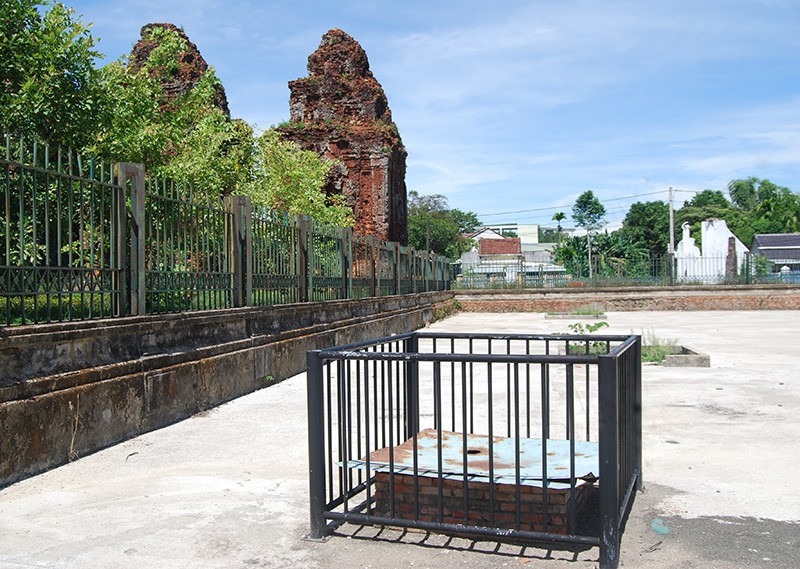
Ancient Cham well next to the Khuong My Cham tower cluster. Photo: HOANG MINH
During the prosperous Trung Phuong port town, Trung Phuong Pagoda was considered a place of pilgrimage for merchants on their long voyages on the East Sea.
Currently, at Trung Phuong pagoda, there are still some types of statues that were offerings from merchants from trading ships docking at Trung Phuong port at that time.
The cluster of 9 ancient Cham wells in Trung Phuong is located on a strip about 400m long, a residential area running along the north - south direction of the sand dunes adjacent to the sea.
According to Mr. Nguyen Chanh - the head of a household with a Cham well in his garden, these ancient wells have been the source of drinking water for residents of the village for many generations. But recently, some households with old wells in their gardens have moved to other places, so some of the wells there have been abandoned, some have been buried, and now there are only 1 wells left.
According to Mr. Chanh, among these 9 wells, there are 3 square wells, the rest are round wells, and the ancients made slightly curved bricks (perhaps they sharpened the bricks) to make it easier to build round.
There is also a well that is built partly square and partly round; There is a well built in a section of sandstone, some gaps during construction are tightly packed with coral. In addition, at Trung Phuong Pagoda there is also a Cham well.
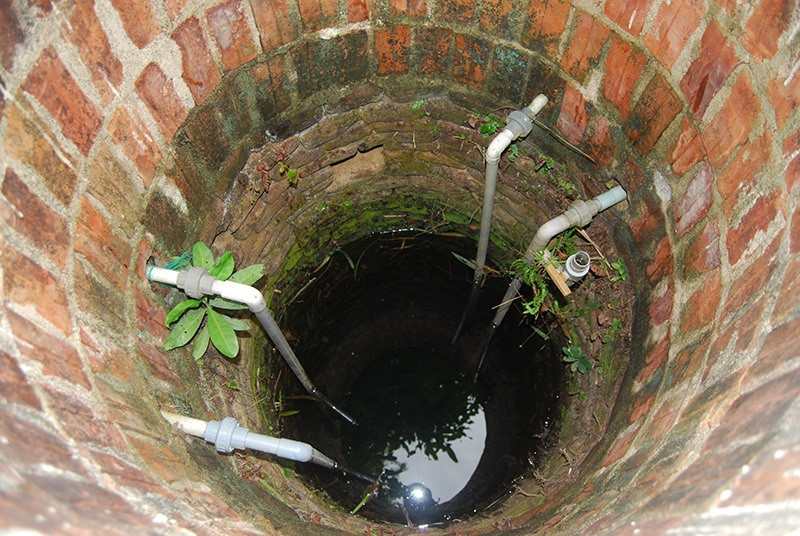
Cham well in Mr. Vo Doi's garden (Tam An commune, Phu Ninh district, Quang Nam province). Photo: HOANG MINH
The ancient wells in Trung Phuong are also magical springs of water. “Back when there were no drilled wells, I used a motor to draw water from my house's old well to water the beans all day without drying up completely. Meanwhile, our people's wells only pump for a few hours before they dry up to the bottom" - Mr. Chanh said.
According to the elders in Trung Phuong, the ancients passed down that the Cham wells here in ancient times were the place to provide fresh water for merchant ships docking at Trung Phuong port to trade or rest and then anchor to continue their journey.
Persian and Arab records from the 8th to 14th centuries collected by Louis Ferrand show that the Cham people dug very clear, sweet and never-drying wells along the coastal sand dunes. to "export" water to foreign merchant ships entering the Champa sea at that time.
Ancient Champa wells - lively "yoni" with eternal cool water remaining are precious artifacts in the museum of life.
Hopefully there will be appropriate research and conservation plans so that the thousand-year-old wells not only won't be lost anymore, but will also discover hidden values from these magical springs of water.

